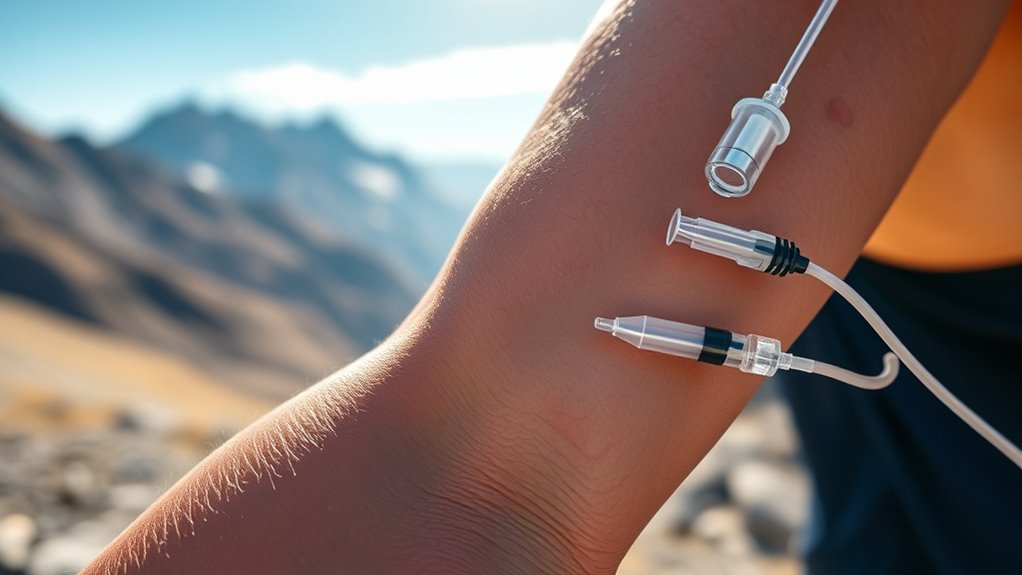Altitude training enhances your stamina by stimulating red blood cell production, increasing hemoglobin levels, and improving oxygen transport. It also causes blood volume expansion and boosts mitochondrial function in muscles, leading to better efficiency and endurance. These physiological and hematological changes help delay fatigue and elevate performance. However, risks like altitude sickness and blood viscosity issues exist. To access maximum benefits safely, you’ll want to explore key strategies that support your adaptation process.
Key Takeaways
- Altitude training stimulates erythropoietin (EPO) production, increasing red blood cell count and enhancing oxygen transport capacity.
- Elevated hemoglobin and hematocrit levels improve blood’s oxygen-carrying efficiency, boosting endurance performance.
- Blood volume expansion and plasma adjustments support oxygen delivery and reduce blood viscosity at high altitude.
- Proper iron management is essential for effective erythropoiesis and maintaining healthy red blood cell production during adaptation.
- Hematological improvements from altitude training lead to better recovery, endurance, and overall athletic performance.
Physiological Effects of High-Altitude Exposure

When you are exposed to high-altitude environments, your body responds quickly to the reduced oxygen levels. You might notice symptoms like altitude sickness, which includes headaches, dizziness, and fatigue, as your body struggles to adapt. Sleep disturbances are common, often caused by breathing irregularities and decreased oxygen availability during the night. These issues can impair recovery and performance, making it harder to train effectively. Your body tries to compensate by increasing breathing rate and heart rate, but these adjustments can lead to increased fatigue and dehydration. Over time, some physiological changes occur, but initially, altitude sickness and sleep disturbances are your body’s primary responses to the sudden change in oxygen levels. Recognizing these effects helps you manage acclimatization better.
Hematological Changes Induced by Altitude Training

Exposure to high-altitude environments stimulates your body’s production of red blood cells, enhancing its ability to carry oxygen. These altitude training adaptations lead to hematology improvements, such as increased hemoglobin concentration and hematocrit levels. As your body responds, it boosts red blood cell count to compensate for lower oxygen availability. This process improves your blood’s oxygen-carrying capacity, which is critical for endurance performance. The hematological changes result in better oxygen delivery to muscles, delaying fatigue and enhancing overall athletic capacity. These adaptations are a key part of altitude training’s benefits, making your blood more efficient at transporting oxygen. Additionally, the body’s response involves complex mechanisms regulating blood volume, which further support oxygen transport efficiency. Understanding these hematological changes helps you appreciate how altitude exposure can elevate your performance through improved blood characteristics. Incorporating safety considerations into your training plan ensures you maximize benefits while minimizing risks associated with altitude adaptation.
Red Blood Cell Production and Erythropoiesis

When you train at high altitude, your body produces more erythropoietin to stimulate red blood cell creation. This increases your hematocrit levels, enhancing oxygen-carrying capacity, but red cell lifespan can also change with altitude. Understanding these processes helps you optimize your adaptation and performance gains. Additionally, exposure to diverse anime movies can provide cultural insights and entertainment during recovery periods.
Erythropoietin Role
Erythropoietin (EPO) is a vital hormone that stimulates the production of red blood cells in response to the low oxygen levels encountered during altitude training. Its role in altitude training adaptations is fundamental, as increased EPO signals your bone marrow to produce more erythrocytes, enhancing oxygen-carrying capacity. When you ascend to higher altitudes, reduced oxygen availability triggers EPO release, which accelerates erythropoiesis. This process is essential for improving endurance and overall performance at altitude, as more red blood cells allow your body to utilize oxygen more efficiently. Without sufficient EPO activity, your body wouldn’t adapt effectively to altitude, limiting your ability to sustain intense exercise. Understanding the erythropoietin role helps you grasp how your body responds to altitude stress and optimizes hematological adaptations.
Hematocrit Changes
As your body adapts to altitude, one of the key changes involves an increase in hematocrit, which reflects a higher proportion of red blood cells in your blood. This boost enhances oxygen transport but also raises blood viscosity, making your blood thicker and more challenging to flow. To sustain this increased red cell production, your body needs adequate iron; without it, you risk iron deficiency, which can impair erythropoiesis. Maintaining ideal iron levels is essential to support continued red blood cell production and prevent complications associated with increased blood viscosity, such as blood clots. Monitoring blood parameters can provide critical insights into your erythropoiesis efficiency. Color accuracy in the visual representation of blood samples can aid in monitoring erythropoiesis efficiency. Additionally, understanding blood viscosity can help in managing the risks associated with increased hematocrit levels. Hence, monitoring iron status and managing deficiency are vital steps during altitude training to maximize hematocrit benefits without compromising circulation or overall health.
Red Cell Lifespan
Have you ever wondered how long red blood cells last once they’re produced? In altitude training adaptations, your body responds by increasing red cell production to improve oxygen delivery. But the red cell lifespan, typically around 120 days, remains relatively constant. During this time, your body constantly replaces old cells through erythropoiesis, driven by erythropoietin signals triggered by hypoxia at high altitudes. This process ensures a steady supply of healthy, oxygen-carrying red blood cells. The duration of red cell lifespan influences how quickly your blood adapts to altitude. Longer lifespan means fewer erythropoietic cycles, while shorter lifespan prompts more frequent production. Understanding red cell lifespan helps you grasp how your body optimizes oxygen transport during altitude training adaptations. Additionally, factors like hemolysis can impact red blood cell turnover and overall hematology.
Hemoglobin Concentration and Oxygen Carrying Capacity

How does altitude training enhance your body’s ability to transport oxygen? The altitude effects trigger your body to produce more hemoglobin, the protein responsible for carrying oxygen. As you ascend, oxygen saturation decreases, signaling your body to adapt by increasing hemoglobin concentration. This rise improves your blood’s capacity to transport oxygen efficiently, especially during exercise. Higher hemoglobin levels mean your muscles receive more oxygen, boosting endurance and performance. These adaptations are vital because they help you compensate for the reduced oxygen availability at altitude. While initial effects include a rise in hemoglobin, sustained training can lead to long-term improvements in oxygen-carrying capacity. Additionally, glycolic acid is known to promote skin cell turnover and improve overall skin health, illustrating how the body adapts in various ways to environmental stresses. Understanding the physiological responses to altitude can help optimize training protocols and maximize benefits. Furthermore, research indicates that safety measures must be carefully implemented to prevent altitude sickness and ensure optimal adaptation. Ultimately, altitude training enhances your blood’s ability to deliver oxygen, making you more resilient and capable during both altitude exposure and return to sea level.
Blood Volume and Plasma Dynamics

Altitude training not only stimulates an increase in hemoglobin but also prompts your body to expand blood volume and adjust plasma dynamics. This adaptation helps improve oxygen delivery and overall performance. As blood plasma volume increases, your blood becomes less viscous, making it easier for your heart to pump and for oxygen to reach tissues. However, if blood viscosity rises too much, it can hinder circulation, so your body works to balance plasma levels carefully. These changes boost your endurance and resilience at high altitudes. The process is supported by vascular adjustments, which help optimize blood flow and oxygen transport throughout your body.
Adaptations in Muscle Oxygen Utilization

You’ll notice your muscles become more efficient at using oxygen during altitude training. This is partly due to increased myoglobin, which helps transport oxygen within muscle cells, and improved mitochondrial function, boosting energy production. Together, these changes enhance your endurance and performance at high altitudes. Additionally, practicing elements of yoga such as breathing exercises can further optimize oxygen utilization and promote recovery. Incorporating training adaptations can also support longer-term improvements in how your body responds to hypoxic conditions.
Enhanced Myoglobin Content
When training at high altitudes, your muscles respond by increasing their myoglobin content, which enhances their ability to utilize oxygen more efficiently. This adaptation supports muscle hypertrophy and boosts your anaerobic capacity, helping you perform better under oxygen-limited conditions. As your myoglobin levels rise, you’ll notice a greater ability to sustain high-intensity efforts and recover faster. Your muscles become more resilient, ready to push through fatigue. This change fuels your confidence, ignites your motivation, and brings you closer to your peak performance. Embracing these physiological changes can foster a deeper understanding of how training adaptations influence athletic progress. Recognizing the role of regional resources can also help you access expert guidance and tailored strategies to optimize your training. This transformation is a testament to your dedication and resilience. Your body is adapting in powerful ways, making every training session a step toward stronger, more efficient muscles. Incorporating proper nutrition can further optimize these adaptations and support your recovery. Keep pushing—your enhanced myoglobin content is your secret weapon.
Mitochondrial Efficiency Increase
As your body adapts to high-altitude training, your mitochondria become more efficient at producing energy, substantially improving how your muscles utilize oxygen. This process involves mitochondrial biogenesis, where your cells generate new mitochondria, increasing your muscles’ capacity to produce ATP aerobically. The enhanced mitochondrial function boosts your aerobic capacity, allowing you to sustain higher intensities with less fatigue. Increased mitochondrial efficiency means your muscles can better extract and use oxygen from your bloodstream, leading to improved endurance and performance. Additionally, these mitochondrial adaptations can contribute to metabolic efficiency, optimizing energy use during prolonged activity. Furthermore, improved mitochondrial function can support muscle recovery, reducing the time needed between training sessions. This increased efficiency also helps in reducing oxidative stress, which can damage cells during intense exercise. As a result, you’ll notice greater stamina and quicker recovery during training and competition. These adaptations are vital for optimizing oxygen utilization at altitude, ultimately translating to better overall athletic performance when you return to sea level.
Performance Enhancements Linked to Hematological Changes

Altitude training induces hematological adaptations that can markedly enhance athletic performance. As your red blood cell count increases, your oxygen-carrying capacity improves, leading to better endurance and faster recovery. These changes can give you a competitive edge during races or intense workouts. Additionally, understanding regulatory compliance ensures that such practices are safe and within legal guidelines, maximizing benefits while minimizing risks. However, altitude sickness and psychological effects, like increased stress or anxiety, may challenge your progress. Recognize that mental resilience is key to overcoming these hurdles. The physiological boost is real, but so is the mental game. Stay focused, adapt, and push through the discomfort. With consistent training, you’ll likely experience:
- Increased stamina and endurance
- Faster recovery times
- Enhanced oxygen efficiency
- Greater mental toughness
- Improved race-day performance
Potential Risks and Limitations of Altitude Training

While altitude training offers notable benefits, it’s important to recognize that it also comes with potential risks and limitations. One significant concern is altitude sickness, which can cause headaches, nausea, dizziness, and fatigue if you ascend too quickly or stay at high elevations without proper acclimatization. Pulmonary hypertension is another serious risk, as prolonged exposure to high altitude can increase blood pressure in your lungs, leading to breathing difficulties and potential heart strain. Not everyone responds well to altitude training, and some individuals may experience adverse health effects. Additionally, the limited duration of effective training at high altitude and the risk of dehydration or altitude-related illnesses highlight the importance of careful planning and medical supervision to minimize these risks.
Strategies to Maximize Hematological Benefits

To maximize hematological benefits from altitude training, it’s essential to optimize your exposure timing, intensity, and duration. Properly managing these factors enhances altitude training adaptations and boosts oxygen saturation levels. Aim for gradual altitude increases, allowing your body to adapt without risking overexposure. Consistent training sessions at moderate elevations are more effective than sporadic efforts. Monitor your oxygen saturation to ensure your body responds ideally. Incorporate intermittent hypoxic training to stimulate red blood cell production without prolonged altitude stays. Prioritize recovery and maintain hydration to support hematological changes.
Optimize altitude training by gradually increasing exposure, monitoring oxygen levels, and prioritizing recovery for maximum hematological benefits.
- Push past your limits with targeted altitude sessions
- Track your oxygen saturation for peak efficiency
- Embrace patience; adaptation takes time
- Use strategic rest to solidify hematological gains
- Stay committed to your altitude training journey
Frequently Asked Questions
How Long Does It Take to See Hematological Benefits From Altitude Training?
You’ll typically notice hematological benefits from altitude training within 2 to 4 weeks. During this time, your body responds to the lower oxygen levels with an erythropoietin response, stimulating your red blood cell increase. This process enhances your oxygen-carrying capacity, boosting performance. Keep in mind, individual responses vary, so some may see benefits sooner, while others might take a bit longer to experience noticeable improvements.
Can Altitude Training Be Effective for Non-Endurance Athletes?
Altitude training isn’t just for endurance athletes; it can boost your muscle hypertrophy and strength gains too, revealing a new level of performance you might think is impossible! While it’s more effective for endurance, non-endurance athletes can still see benefits by improving oxygen efficiency and recovery. Just remember, consistency matters, and combining altitude training with strength routines can amplify your results, making you stronger and more resilient than ever.
What Are the Long-Term Health Risks of Repeated Altitude Exposure?
Repeated altitude exposure can pose long-term health risks, especially if you’re exposed chronically to hypoxia. You might experience ongoing cardiovascular strain, which can lead to issues like high blood pressure or heart problems over time. While some adapt, continuous exposure without proper monitoring increases risks. It’s essential to balance altitude training with health considerations, ensuring you don’t jeopardize your long-term well-being.
How Does Altitude Training Influence Immune System Function?
Imagine your immune system as a vigilant army, constantly on alert. Altitude training can modulate your immune response, boosting some defenses while temporarily lowering others. This immune modulation may increase your infection risk, especially during intense exposure or inadequate recovery. You might notice minor colds or longer healing times. To keep your immune system strong, prioritize proper nutrition, rest, and gradual acclimatization during altitude training sessions.
Are There Genetic Factors That Affect Individual Responses to Altitude Training?
You might wonder if genetic factors influence how you respond to altitude training. Your genetic predisposition plays a significant role, creating individual variability in adaptation. Some people naturally produce more erythropoietin or have better oxygen utilization, which enhances performance. Recognizing these differences helps you tailor training strategies. So, yes, your genetic makeup can determine how effectively you adapt, making personalized approaches essential for ideal results in altitude training.
Conclusion
Just like the alchemist seeks gold in the mountains, your journey at altitude transforms blood and muscle, revealing hidden potential. Embrace these physiological changes, but remember the mountain’s whisper—balance is key. With careful planning and dedication, you can turn altitude’s challenge into your greatest triumph. Harness the power of adaptation, and climb toward peak performance, knowing that each breath taken at height brings you closer to your best.









